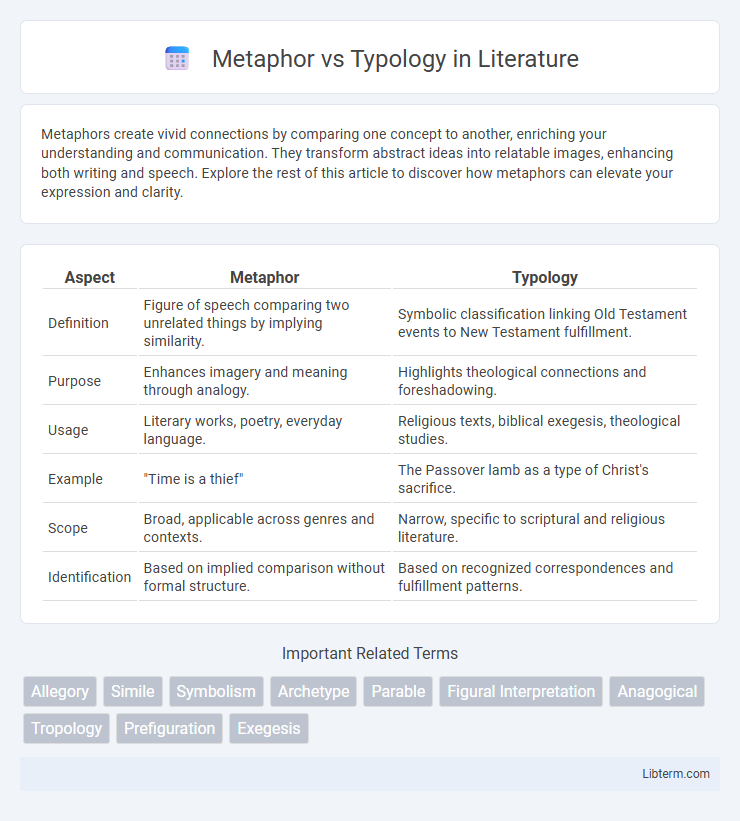Metaphors create vivid connections by comparing one concept to another, enriching your understanding and communication. They transform abstract ideas into relatable images, enhancing both writing and speech. Explore the rest of this article to discover how metaphors can elevate your expression and clarity.
Table of Comparison
| Aspect | Metaphor | Typology |
|---|---|---|
| Definition | Figure of speech comparing two unrelated things by implying similarity. | Symbolic classification linking Old Testament events to New Testament fulfillment. |
| Purpose | Enhances imagery and meaning through analogy. | Highlights theological connections and foreshadowing. |
| Usage | Literary works, poetry, everyday language. | Religious texts, biblical exegesis, theological studies. |
| Example | "Time is a thief" | The Passover lamb as a type of Christ's sacrifice. |
| Scope | Broad, applicable across genres and contexts. | Narrow, specific to scriptural and religious literature. |
| Identification | Based on implied comparison without formal structure. | Based on recognized correspondences and fulfillment patterns. |
Understanding Metaphor: Definition and Purpose
Metaphor is a linguistic and cognitive device that conveys meaning by relating one concept to another, often abstracting complex ideas through familiar imagery to enhance comprehension and emotional impact. Its purpose is to create connections between disparate domains, facilitating deeper understanding and communication by highlighting underlying similarities. Unlike typology, which systematically categorizes and compares elements based on shared features, metaphor relies on imaginative association to evoke insight and meaning.
Defining Typology: Meaning and Applications
Typology is a method of classification that organizes objects, concepts, or phenomena into distinct categories based on shared characteristics and underlying patterns. It is widely applied in fields such as theology, linguistics, archaeology, and anthropology to analyze symbolic relationships and historical continuities. Unlike metaphors, which draw imaginative comparisons, typology emphasizes systematic categorization to reveal inherent structural connections and meanings.
Historical Roots of Metaphor and Typology
Metaphor, rooted in ancient rhetoric and philosophy, traces back to Aristotle's Poetics where it was defined as the transfer of meaning between disparate concepts to create new understanding. Typology, emerging from early Christian theology, specifically interprets Old Testament events and figures as prefigurations of New Testament fulfillments, establishing a framework for biblical interpretation. Both metaphor and typology share historical significance in shaping literary and theological analysis, influencing how texts communicate layered meanings across time.
Key Distinctions Between Metaphor and Typology
Metaphor involves understanding one concept through the lens of another, highlighting a relational similarity based on shared attributes, while typology classifies entities into categories based on inherent characteristics and systematic criteria. Metaphors function primarily as cognitive and linguistic tools for meaning transfer and conceptual mapping, whereas typologies serve as analytical frameworks for organizing data or phenomena into distinct, non-overlapping groups. The key distinction lies in metaphor's emphasis on analogy and figurative comparison, contrasting with typology's focus on classification and hierarchical structuring.
Functions of Metaphor in Language and Literature
Metaphor functions as a cognitive tool in language and literature by mapping similarities between disparate concepts, enabling abstract ideas to be expressed concretely and enhancing understanding. In literary contexts, metaphors enrich narratives by evoking vivid imagery and emotional resonance, facilitating deeper reader engagement. Unlike typology, which categorizes and establishes relationships within fixed schemas, metaphor operates dynamically to generate new meanings and perspectives through symbolic association.
Role of Typology in Analysis and Classification
Typology plays a crucial role in analysis and classification by systematically categorizing data based on shared characteristics, enabling clearer pattern recognition and structured interpretation. Unlike metaphor, which relies on symbolic and figurative meanings to convey concepts, typology provides a framework for organizing information into distinct types for comparative study. This method enhances analytical precision by grouping similar phenomena, facilitating more effective communication and understanding across disciplines.
Examples of Metaphor in Everyday Communication
Metaphors are pervasive in everyday communication, serving as powerful tools to convey complex ideas through familiar images, such as describing time as a "thief" that steals moments or calling someone a "night owl" to indicate late-night activity. Unlike typology, which categorizes concepts into distinct types or classes for systematic analysis, metaphor bridges abstract concepts with sensory experience, enhancing understanding and emotional resonance. Common metaphorical expressions like "breaking the ice" or "a rollercoaster of emotions" illustrate how language shapes perception by linking intangible experiences to concrete actions and objects.
Real-World Applications of Typological Analysis
Typological analysis plays a crucial role in fields like linguistics, anthropology, and software engineering by classifying phenomena based on shared characteristics, enabling systematic comparison and pattern recognition. In anthropology, typology helps analyze cultural artifacts and social systems to trace human development and interaction, while in software engineering, it supports the design of scalable and maintainable code architectures through type hierarchies and templates. Unlike metaphors that rely on symbolic representation, typological analysis provides concrete frameworks essential for empirical research and practical problem-solving across disciplines.
Intersections: When Metaphor Meets Typology
Metaphor and typology intersect in cognitive linguistics by revealing how abstract conceptual mappings underlie language patterns and cultural classifications. Metaphor involves understanding one domain in terms of another, while typology categorizes linguistic and cultural phenomena based on structural similarities and differences. Exploring their intersection uncovers how metaphorical structures can influence typological classifications, enhancing the understanding of semantic universals and cognitive processes across languages.
Choosing Between Metaphor and Typology in Interpretation
Choosing between metaphor and typology in interpretation depends on the intended depth and purpose of textual analysis, where metaphor emphasizes symbolic or imaginative representation while typology reveals a structured correlation between events or figures across contexts. Metaphor allows for flexible, creative understanding by highlighting similarities that evoke new meanings, whereas typology requires a recognized, often theological or historical continuity that aligns earlier occurrences with later fulfillments. Interpreters must evaluate the nature of the text and their exegetical goals to decide if the passage invites imaginative symbolism or a predetermined pattern of fulfillment.
Metaphor Infographic

 libterm.com
libterm.com